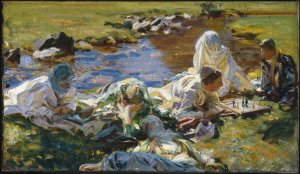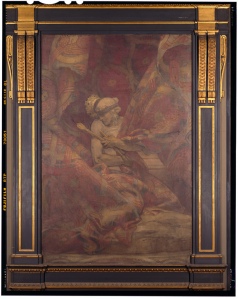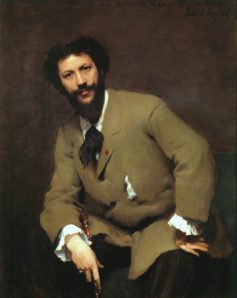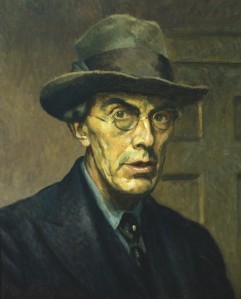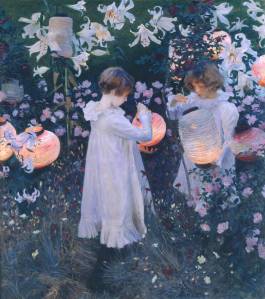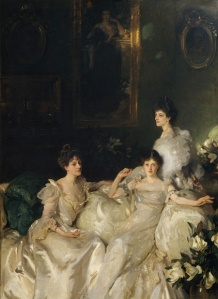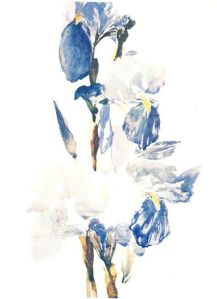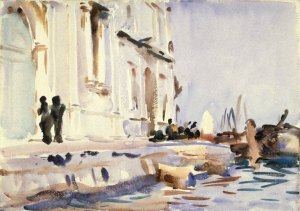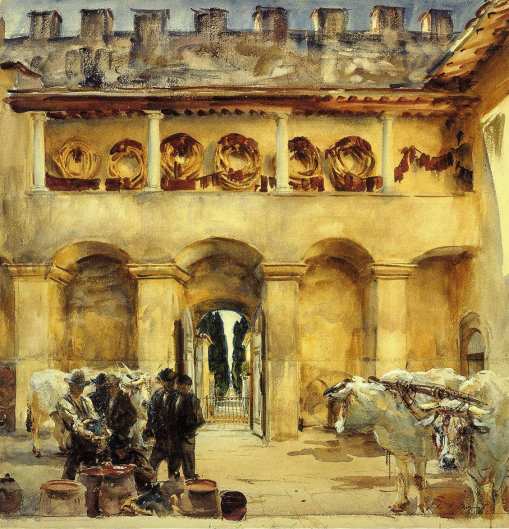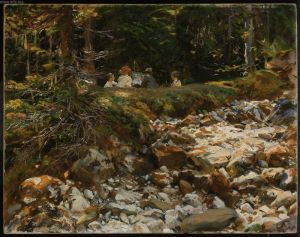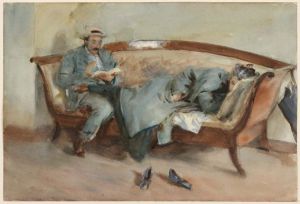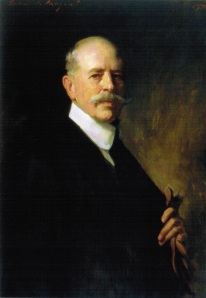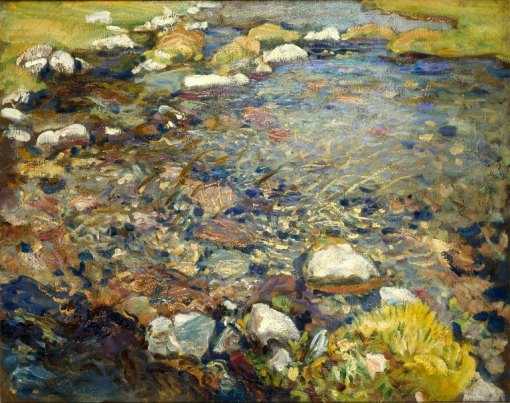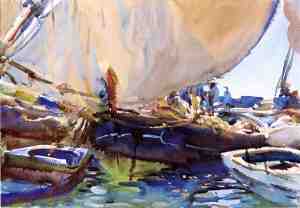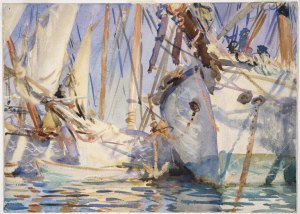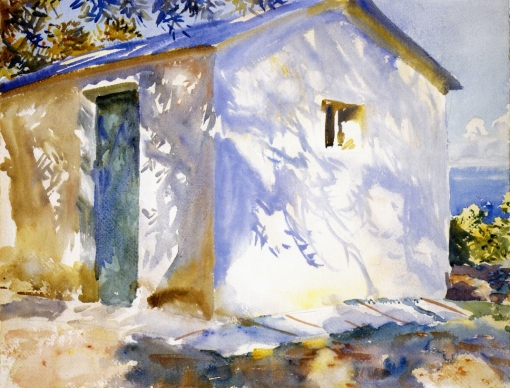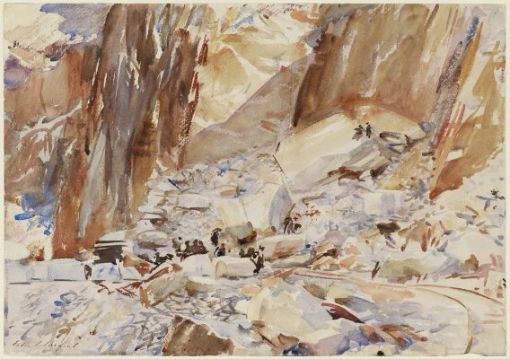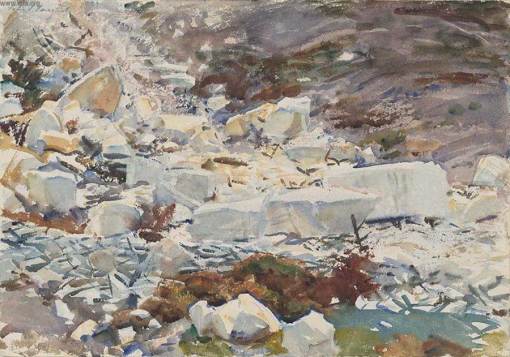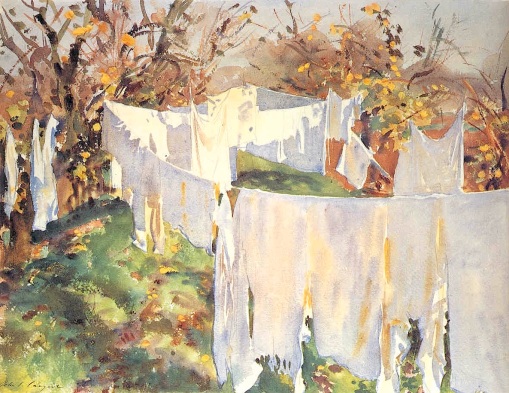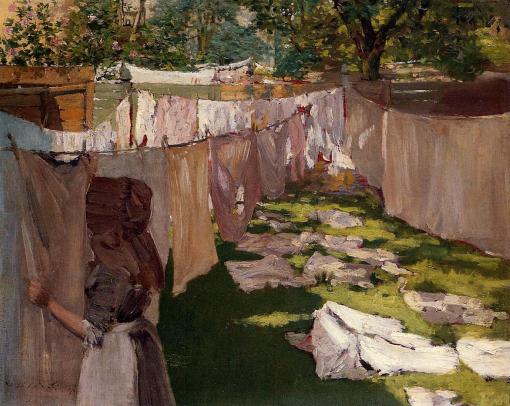Turner’s Whaling Canvases (and a little Melville)
A small exhibit at the Metropolitan Museum in Manhattan (through August 7, 2016) shows that in the late 1840s it was not only Herman Melville who was thinking about the business of whaling as a subject fit to expand an art form. The Met has re-assembled the four oils J.M.W. Turner painted around 1845 that treat the dangerous, bloody and seemingly existential business of whaling by putting together in the same room for the first time since they were in Turner’s studio its own Whalers together with the other three related ones, all of which are now owned by the Tate. While these few paintings might seem a thin reed to base a Melville–Turner connection, if you read to the end, you might find some interesting points of connection (and some wild conjectures).
Turner and the Sea

1. Fishermen at Sea by J.M.W. Turner. ca. 1792. Oil on canvas. Tate. London. (BJ 1.) (As with all the illustration in this post, click to enlarge and click again to enlarge further.)
For some, Turner was principally, if not exclusively, a landscape painter. At the Met last week, I was surprised when a woman remarked to me (out of nowhere), “I thought Turner was a landscape painter.” John Ruskin, Turner’s early and greatest champion, also saw him as principally a landscape painter, and that’s how he’s treated in Modern Paintings.1 But maritime works were a core part of his output. The first painting the 21 year old Turner exhibited, his Fishermen at Sea [#1], was a maritime picture but also a breathtaking production that made the familiar dramatic with bold lighting from the moon illuminating a boat atop an undulating sea defined by dark water and white crests, white reflections and white birds. The chiaroscuro effect emphasizes the power of the sea and also implies that the water nests the fishermen who appear serene in the midst of the surges.
Turner was elected to the Royal Academy in 1802. when he was 27, owing in large part to his Dutch Boats in a Gail [the “Bridgewater Seapiece”] (1801; BJ 14), which was a popular success when exhibited to the Royal Academy in 1801 and was considered by Henry Fuseli and Benjamin West to surpass the Dutch models and even Rembrandt! From then on maritime subjects became a staple for Turner. A maritime painting was the first of Turner’s paintings to be engraved. (The painting The Shipwreck (BJ 54), exhibited in 1805, was engraved by J. Burnet in 1853.) Hermann (p. 1) found that 150 of the 541 oils catalogued by Butlin and Joll have the sea as its central feature, and this doesn’t count historical/mythological pictures or views of harbors or Venice.

2. The Wreck of a Transport Ship by J.M.W. Turner. (Oil on canvas. ca. 1810. Fundaçao Calouste Gulbendikan, Lisbon.) (BJ 210.)
The sea with men aboard vessels was a subject that was not only dramatic in itself, but also one central to the psyche of the island nation who allowed its rulers to impress (British navy term for “kidnap”) foreign seamen so that its own navy and merchant marine could continue to supply the nation of shopkeepers with its economic vitals. Britannia took pride in ruling the oceans, and Turner was more than willing to become its visual chronicler, booster and sometime critic. Between Dutch Boats in a Gale and Wreck of a Transport Ship [#2] Turner had a “decade of painting grand seapieces” which he would not return to until the late 1820s (BJ 210). When Turner took up seascapes again, this time more or less regularly, with Port Ruysdael, exhibited in 1827 (BJ 237), he would concern himself with churning seas, which Ruskin described as the “white, wild, cold, comfortless waves of the north sea” which in the composition are “almost subordinate to the awful rolling clouds.” (Modern Painters I:379.) To Ruskin Turner was the undisputed master of both the sky and the sea:

3. Margate from the Sea: Whiting Fishing by J.M.W. Turner. Watercolor on paper. 1822. Private collection.
“it may be generally stated that Turner is the only painter, so far as I know, who has ever drawn the sky, (not the clear sky, which we before saw belonged exclusively to the religious schools, but the various forms and phenomena of the cloudy heavens,) all previous artists having only represented it typically or partially; but he absolutely and universally … He is the only painter who has ever represented the surface of calm, or the force of agitated water; who has represented the effects of space on distant objects, or who has rendered the abstract beauty of natural color. These assertions I make deliberately, after careful weighing and consideration, in no spirit of dispute, or momentary zeal; but from strong and convinced feeling, and with the consciousness of being able to prove them.” (MP I:138-39).
To achieve mastery of skies and seas, particularly turbulent ones, the treatment of light (including reflection, chiaroscuro and diffusion) as well as color (although the more experimental approaches to color came later) needed to be subordinated to his overall approach. Like many Romantic painters (including those of the more-or-less contemporary American Hudson River School) Turner began with a fondness for lighting the picture from a central source in the background. As time went on, Turner used sunlight in both seascapes and landscapes that approached closer to the horizon (see Margate from the Sea [#3]). As he increased the intensity of the light, it threw the forms on both sides into something like relief. In Regulus (rev. 1837) [#4] the viewer sees sunlight so intense that it obscures the objects on either side of its direct rays. The effect was one that Turner vigorously applied himself to create. John Gilbert, whose own exhibit was on the opposite wall to Turner’s at the British Institution exhibition, saw Turner rework the piece in 1837:

5. Ancient Italy—Ovid Banished from Rome by J.M.W. Turner. Oil on canvas. 1838. Private Collection. (BJ 375.)
“The picture was a mass of red and yellow of all varieties. Every object was in this fiery state. He had a large palette, nothing in it but a huge lump of flake-white; he had two or three biggish hog tools to work with, and with these he was driving the white into all the hollows, and every part of the surface. This was the only work he did, and it was the finishing stroke. The sun, as I have said, was in the centre; from it were drawn—ruled—lines to mark the rays; these lines were rather strongly marked, I suppose to guide his eye. The picture became wonderfully effective, just the effect of brilliant sunlight absorbing everything and throwing a misty haze over every object.” (BJ 294.)

6. Snow Storm—Steam-Boat off a Harbour’s Mouth by J.M.W. Turner. Oil on canvas. 1842. Tate, London. (BJ 398.)
A similar concept (also of an ancient historical setting) was used the following year in Turner’s Ancient Italy—Ovid Banished from Rome [#5]. The critics were not charitable to these experiments. Ruskin, after Turner’s death (in his 1857 Notes) found Regulus to be “very disgraceful to Turner,” and the Anthenaeum (May 12, 1838) concluded on the basis of Ancient Italy that it was “grievous to think of talent, so mighty and so poetical, running riot into such frenzies; the more grievous, as we fear, it is now past recall.”
Storms at sea as well as night on the ocean required Turner to understand how to express the absence of light, and he engaged in a similar path of experimentation. In Snow Storm—Steam-Boat off a Harbour’s Mouth making signals in Shallow Water, and going by the Lead [#6], he painted a swirl of light and dark encircling a craft listing in mortal danger. Turner added a subtitle: “The Author was in this Storm on the Night the Ariel left Harwich.” It is less important that the documentary evidence does not support this claim than the fact that Turner called himself an “Author” not “Artist.” The painting was intended to be journalistic; that is, recorded by an observer. And to our eyes the painting has real authenticity. But the contemporary critics found the work insufficiently representational. Punch and other satirists routinely compared Turner’s work of this period to various salads and the Anthenaeum (May 14, 1842) condemns Turner for using “his whole array of kitchen stuff. Where the steam-boat is—where the harbour begins, or where it ends—which are the signals, and which the author in the Ariel … are matters past our finding out.” The idea that the piece should be criticized for expressing the emotional intensity of experiencing the storm’s ferocity instead of subordinating it to a “literal” depiction of physical forms and relationships (one that could not be seen under the circumstances portrayed) seems odd to us who have absorbed a century and a half of developments in painting and other pictorial technology. But the radicalness of the approach, pre-Impressionism and before the New was celebrated, can be perhaps best understood by considering that Ruskin himself expressed (privately) his view that the work was nothing more than “whitewash and soapsuds.”2 When Turner combined his mastery of intense light, pure blackness and his experiments with reds and yellows of early 1840s, he produced Peace [#7], a visual threnody of surprising power. What did the most informed art writers of his time think of it? Clarkson Stanfield of the Royal Academy thought the sails were too black. The newspaper critics were uniformly hostile, with the Spectator (May 7, 1842), insinuating its lack a patriotism (or its radicalness) by dubbing it “rouge et noir.” Other newspaper commentators competed to make even less witty disparaging remarks. But even Ruskin (in his 1857 Notes) criticized the “unnatural blackness of the sails.”

8. Slavers Throwing Overboard the Dead and Dying by J.M.W. Turner. Oil on canvas. 1840. Museum of Fine Arts, Boston. (BJ 385.)
The most effective of Turner’s black-red-yellow experiments was Slavers Throwing Overboard the Dead and Dying (1840; BJ 385) [#8]. Turner here subordinates composition to the interplay of colors. The most clearly defined object is a human leg surrounded by fish in the right foreground. Hands appear to be sticking up from the sea further back. We see a ship somewhat obscured by the mist or fog. What the painting essentially consists of is the layering of black, yellow, red and white (with a few other colors for details). The interplay of the colors makes up the sea, which imperceptibly becomes the sky, which, in turn, takes up half the canvas. Turner regarded it as the noblest sea Turner ever created, and, therefore, “the noblest ever painted by man.” The ship is forcing its way through uneasy surf, moving away from the central light (lightning?) but framed in an ominously red sky. The production heaves with moral revulsion.

9. Van Tromp’s Shallop at the Entrance of the Scheldt by J.M.W. Turner. Oil on canvas. 1832. Wadsworth Atheneum, Hartford, Connecticut . (BJ 344.)
The newspapers once again objected to the lack of sharp definition of objects. And it is certainly true that the works of the 1840s were considerably less “representational” than those of the 1830s, such as the Von Tromp’s Shallop [#9]. The older paintings followed the approach that had come to be accepted among Dutch painters earlier in the century. The Dutch attempted a sort of “verisimilitude” that made the objects throughout the painting distinct, even though a person viewing the scene in nature could not see the actual scene in that way, most of the scene being confined to peripheral vision. But in the 1830s Turner had departed from the Dutch models by adding atmospheric perspective so that German art historian Gustav Friedrich Waagen considered Turner’s approach as “a crude painted medley with a general foggy appearance” constituting a “total want of truth.”3 Ruskin expends a great deal of effort in defending Turner from this kind of criticism by way of a minute explanation of the nature of atmospheric perspective (the effect of air, depending on its moisture content, to make more obscure and paler distant objects, to the extent of their distance), although he had no term for it, simply calling it one of the intentional “mysteries” of Turner’s painting. (MP, IV:68-79.) It is in the context of Ruskin’s defense of Turner’s renderings of skies and clouds (and by extension distant objects) that Ruskin makes his provocative statement: “We never see anything clearly.” (MP IV:58.) That defense, however, depended upon rendering the forms “definite”: “You can only show how the light affects the object, by knowing thoroughly what the object is; and noble mystery differs from ignoble, in being a veil thrown between us and something definite, known, and substantial; but the ignoble mystery is a veil cast before chaos, the studious concealment of Nothing.” (MP IV:73.) This is where Turner and Ruskin (at least the younger Ruskin) parted ways. And it is why Ruskin denigrated the first of the whaling canvases at the Met exhibit.4
Turner, Whales and Whalers

*10. The Whale on Shore by J.M.W. Turner. Watercolor on paper. ca. 1837. Taft Museum of Art, Cincinnati, Ohio. (The asterisk—*—indicates the piece is shown as part of the Metropolitan Museum’s exhibition.)
It was during his new, more expressionistic, departure in the 1840s that the whaling projects were conceived. Turner had only once before taken any interest in whales and that was a watercolor [#10] designed to be engraved for an illustration to a multivolume collection of Walter Scott works (specifically to an abridgment of The Pirate). The work is strikingly busy. The scene represents an important plot point in the novel. During an attempt to kill a whale the pirate of the title (who had earlier been saved by the hero) rescues the hero from drowning. Their obligations now cancelled out, they may begin their rivalry for the same love interest. Even given the elaborate and fully populated scene by Scott, it is remarkable how many things are going on in Turner’s picture. The whale is near shore in the midground right. The rescue takes place in the foreground. A thunderstorm is off shore to the left. And the whale is being harassed by boats and attacked with all sorts of weapons including muskets. The picture is filled with scores of people. The composition was perhaps designed to give a flavor of the fanciful nature of the novel. In the midst of the chaos, the whale itself is quite odd. Hamilton (p. 94) says that it has the look of a “post-medieval bestiary woodcut illustration.” It is interesting to note, however, that the whale is clearly a right whale, the kind of whale most common in the North Atlantic, and not a sperm whale, which Turner would paint in his canvases.5 Neither the style nor the content of the painting, however, prefigures the whale canvases.

11. Peche de la Balein by Frederic Martens. Uncolored aquatint after a painting by Ambroise Louis Garneray, published by Rittner & Goupil, Paris, 1834-35.
Hamilton (p. 92) suggests as a possible guiding influence on Turner’s mid-1840 departure in maritime works the affable old Yankee mariner Captain Elisha Ely Morgan, who regularly appeared in London, owing to his packet service between New York and London and Liverpool. While in London Morgan cultivated the foremost literary and artistic lights, including Dickens and Thackeray. Turner became such an enthusiast of Morgan’s tales of the open sea (Turner himself never made an ocean voyage) that the two became close; so close that Morgan added Turner to the list of his intimates who were sent a box of American cigars when Morgan returned to New York. Hamilton speculates that Morgan’s stories may have influenced Turner’s evolution in sea painting from the academically-based paintings of the 1830s to the dramatic and emotion-filled pictures of the 1840s. (It may not be a coincident that Morgan was an abolitionist, and Turner painted the Slavers in 1840.) Morgan had also spent a year whaling in Greenland, so that might have been an impetus to the specific project. But Turner had other sources of inspiration.

12. Boats Attacking Whales by William James Linton. Engraving published as frontispiece to Beale’s Natural History of the Sperm Whale (1839).
Natural history, and the order of the living world, was a component of English cultural conversations in the 1840s and for many years before that. The five volumes written by various naturalists under the supervision of Charles Darwin describing the specimens he collected during the voyage of the H.M.S. Beagle were published from February 1838 to October 1843 (under the general title Zoology of the Voyage of H.M.S. Beagle). Darwin’s own Journal and Remarks on the voyage (which contains references to whales and whaling throughout) was published in 1840.6 The Beagle was only one of a number of government sponsored expeditions, designed to explore sea routes but also to report on and collect new or little known organisms as a matter for scientific research. Specifically with respect to whales, although the British whaling industry was at depression levels owing to foreign (mainly Yankee) competition, whaling still captured the public’s attention. There was a fair amount of conventional art, including popular engravings [e.g., #11], as well as travelogues, histories of voyages and even literature. (Melville’s Typee, which was first published in London in 1846 and well received, portrayed sailors from the whaler The Dolly). Perhaps most important of the authentic descriptions of whaling was Thomas Beale’s Natural History of the Sperm Whale (1839), which both Turner and Melville consulted.7 While the illustrations were fanciful [e.g., #12 with sperm whales frolicking and leaping wholly out of the water in the manner of dolphins], the text, written by a British surgeon, strove for accuracy not only about whales but also about a whaling voyage that Beale himself undertook.

13. Wreckers–Coast of Northumberland, with a Steam-Boat Assisting a Ship off Shore b y J.M.W. Turner. Oil on canvas. 1834. Yale Center for British Art, New Haven, Connecticut.
Financially Turner’s biggest inspiration probably was the rich spermaceti magnate Elhanan Bicknell, who had long been in the whaling business but had liquidated his investments before the bust. He was now a wealthy connoisseur of British painting, including Gainsborough, Landseer, Stanfield, Etty and others, and had previously patronized Turner. According to Sutton, he became a champion (or at least a purchaser) of Turner before even his friend John Ruskin did. In the year before Turner painted the first two whaling oils, Bicknell purchased eight canvases by Turner.8 (The year 1844, however, was the year after the first volume of Ruskin’s Modern Painters was first published, and it caused something of a bull market in Turner works.) Among the works of Turner he bought was Wreckers [#13], a work that received universal praise on its exhibitions at the Royal Academy in 1834 and the British Institution in 1836. Turner’s attempt to reel in Bicknell was not only unsuccessful, however, it also resulted in a permanent breach in their relationship.
In 1845 the 70 year old Turner was interim president of the Royal Academy. For his contribution to that summer’s annual exhibition (he was a member of the hanging committee) he selected his two whaling paintings [##14 & 15] together with four Venetian scenes. The whaling canvases both involve what whalers called the “chase,” and the entries in the 1845 catalogue both refer to chapter XIII of “Beale’s Voyage” (i.e., Beale, Natural History of the Sperm Whale) for a description of the action. Beale describes the chase and capture as follows:

*15. Whalers (The Whale Ship) by J.M.W. Turner. Oil on canvas. 1845. Metropolitan Museum of Art, New York. (BJ 415.)
“When in pursuit of the whale with the boats, it occasionally happens that just at the moment the harpoon is about to be plunged into its body, the whale suddenly descends, leaving nothing but a vortex to mark the spot where but a moment before it was seen floating; but its course, however, has been observed, and the boats are placed in a position to be as near as possible to it when it again rises to breathe; the time, as has been before stated, when he will do this is known to a minute. If they should be more fortunate in the next rising of the whale, and they succeed in darting the harpoon into its body, then immediately after the first struggles of the wounded animal and when he is lying exhausted from his enormous exertions to escape, or free himself from the harpoon, the boat’s head is placed close to its side, and the headsman begins to destroy it by thrusting his lance into its most vital parts, which lie near the fin, or darting at it from a distance; at the moment of lancing, he cries ‘stern all’; the oars are then immediately backed and the boat’s stern becoming its cutwater, it is thus removed from danger without the loss of time and trouble in turning. Again, when feeling the lance, the whale plunges and throws itself in all directions, lashing the water with its tail, or rearing its enormous head, and threatening destruction with its formidable jaw, (see cut, p. 154).” (pp. 159-60).
The two paintings represent sequential events. The first (BJ 414) [#14] shows the whale boats in the process of harpooning the whale. The harpooner in the stern of the boat (the foremost of the human figures) is about to throw. The one slightly behind has no harpoon in hand and is perhaps cheering a hit. The whale is seen as only a brown mound to the right. Its spout is slightly pink, showing that it has been injured enough to be exhaling blood. The men are pulling back the oars, the very thing Beale describes they do after the headsman cries, “stern all.” What is most remarkable about the painting, however, is the whiteness of the spray which obscures the scene and blends into the sky and sails of the distant ship. The oval effect created by the spray and clouds curving over the heads of the whalers creates a sense of urgency to the action. Also demanding notice is the color that Turner uses to create the bright pacific sun over the sea. The Spectator (May 10, 1845) remarked on the “prismatic brilliancy” of the “hues of light.” The Literary Gazette (May 17, 1845) concluded that Turner’s “scale of color has never … been approached by any other man; … it is a development of elements essential in nature, carried far above her usual aspects.” The color must have faded over time, because the Morning Chronicle (May 7, 1845) praises the effect of the “red clothing of the sailors in the boat” which now appear brown. This may be an example of Turner’s point that owing to the materials used, Turner’s colors are not permanent.9 But even with the fading, the sense is one of blinding white sunlight in the mist.
The second painting (BJ 415) [#15], which shows the whale’s breach that followed its sounding on being harpooned, is at initial glance a more iconic composition. The head of the whale is seen in the foreground with the ship seemingly chasing it. To the right there is a large splash, possibly caused by the whale’s fluke. On closer inspection between the whale and the ship are the boats struggling against the waves caused by the whale’s actions. One boat seems to have capsized, another is in the process of being upended with whalers holding the sides, and the third seems just beginning to feel the effects of the upheaval of the ocean. The story from Beale (pp. 173-76) is of an operation off Japan in June 1832. It was late afternoon when the whale was harpooned and successfully lanced, but it sounded deep and when it breached it hit one boat with its head upending it. It circled the men in the water, but did not harm them. When the whale was again lanced, it died and sunk, never to be seen again. The men, however, were all rescued. The culmination of the two scenes then is a near death experience ending in ultimate futility, a conclusion that Turner often urges for all manner of human endeavor, especially by quoting from his (never found) poem “Fallacies of Hope.”
Like its companion piece, in the second Whalers the atmospheric perspective is made through a brilliant foreground lighting effect rather than solely through darker tinted backgrounds. And unlike Regulus [#4] and its “huge lump of flake white forced into all the crevices of the canvas,” the brilliance of the surface was made up of different hues and tints. While Punch (January-June 1845, p. 233) compared its effects to that of “lobster salads,” the critic for the Literary Gazette (May 17, 1845), while preferring Turner’s earlier work (because it did not “sublimate truth” to imagination) saw that the “handling of the tints, and their harmony, allowing for the exalted pitch of prismatic brightness, are astonishing. Splintered rainbows thrown against the canvas is a better comparison than … lobster sauce … .”
Bicknell took home the second of the Whalers but discovered that it was finished in part with water color, and he took that as a sign that Turner had not given enough time or care to finish the work properly. He attempted to remove the watercolor himself and damaged the work. A confrontation with Turner arose when he returned it for Turner to re-finish. Turner dug in his heels, and the dispute soon merged with another one,10 the combination of which seems to have ended their personal relationship.

*18. Hurrah! for the Whaler Erebus! Another Fish!’ by J.M.W. Turner. Oil on canvas. 1846. Tate, London. (BJ 423.)
Nothing discouraged, Turner undertook to paint two more whaling paintings for the next year’s Royal Academy show. The first, Hurrah! for the Whaler Erebus! another Fish! [#18], depicts the “cutting in” process for a whale that has been hauled in (see chapter 67 of Moby Dick for a description) and the “baling of the case” (Moby Dick, chapters 77 and 78). The second, Whalers (boiling Blubber) entangled in Flaw Ice, endeavouring to extricate themselves [#19], shows the final stage of the process of rendering fat into commercial oil. But like the first pair, this pair begins with a euphoric moment (a catch that fills the hold?) and ends with a potential disaster—the ship trapped in packed (flaw [sic]) ice. In fact, if you look at the four paintings in order, you can discern the sequence of the business of obtaining spermaceti and other oils from the sperm whale: first the chase, then the (unsuccessful) kill, then the cutting in and retrieving the spermaceti from the head and finally boiling the blubber for residual oil. But the two sets are also distinct. Not only do the 1845 paintings and the 1846 ones take place in different seas (a point I will discuss below), but their focus is also different. The first set observes men confronting nature, and they do it with sheer brute manpower. There is no sign of machines or technology (beyond simple Iron Age tools). In the 1846 set the focus is on the manufacturing aspect of whaling: retrieving the spermaceti, cutting in and rendering the blubber. The last painting shows how industrial methods have been brought to this far-away sea by means of the try-works (see Moby Dick, chapter 96). It is true that disaster faces this crew too (in the form of the ice pack), but that is simply part of the order of things: the fallacy of hope; it is not a condemnation of industry itself.

*19. Whalers (Boiling Blubber) Entangled in Flaw Ice, Endeavouring to Extricate Themselves by J.M.W. Turner. Oil on canvas. 1846. Tate, London. (BJ 426.)
For a long time art historians had seen this second pair as depictions of whaling in the Arctic, and then criticized Turner for details that were unrealistic. There was no commercial whaler known as Erebus, sperm whales are rare in the Arctic, Arctic whalers did not boil blubber and so forth. Wallace (1988), however, persuasively showed that the painting were of Antarctic waters and that Erebus was not a commercial whaler but rather a former bomb ketch refitted as a research vessel, sent (with another converted bomb ketch, the Terror, which had seen service in the War of 1812 against the United States) to explore southern sea lanes, to investigate the magnetism of the earth and also to “use every exertion to collect the various objects of Natural History which the many heretofore unexplored countries about to visited would afford.” (Richardson & Grey, p. v.) The youngest member of the expedition (which took place from 1839 to 1843) was the 22 year old Joseph Dalton Hooker, who would become one of the eminent botanists (specializing in geographical botany) and evolutionists in England and Darwin’s closest friend, defender and confidant. (He wrote the “Summary of the Voyage” which introduced Richardson & Grey’s first volume of the zoology of the voyage.) As a member of the Anthenæum Club, Turner would have known a number of persons familiar with the voyage, including Hooker’s respected father, William Jackson Hooker.11 Wallace speculates that Turner might have even talked with expedition commander Captain James Clark Ross when he returned to London in 1843.
The relevance of the location depicted may have to do (as Wallace argues) with the nature of the illumination of the objects in the two pictures. Unlike the bright light of the first set of whalers which runs towards a warm color temperature, the color temperature of the second set is decidedly cooler, more bluish, even though the intensity seems the same. Wallace (1988, p. 27) says that the 1846 paintings give off “a wondrous radiance that is almost benedictory in its quality”; the first one having a “copper calm” and the second a “shimmering azure transparency.” Sympathetic contemporary critics struggled to explain what Turner was trying to achieve, but they nonetheless remarked on the handling of color. About the first painting [#18] the Literary Gazette (May 9, 1846) said: “So entirely is the eye carried away by a sort of indistinct and harmonious magic, that we seem to consent to the abandonment of solid truth and real nature altogether, and allow dark ships to be chrome yellow, whales glittering pink, human beings sun or moon beams, and little thick dabs of paint ethereal clouds.” The Anthenaeum (May 9, 1846) praised the Boiling Blubber picture for allowing the viewer to make out forms, although color still predominates: “one can make forms out of those beautiful, though almost chaotic colours. The sea-green hue of the ice, the flicker of the sunbeam on the waves, the boiling of the blubber, and the tall forms of the ice-bound vessels, make up an interesting picture.” Given Ruskin’s remark about the impermanence of Turner’s colors and the inference that the color of the sailors’ outfits in #14 faded considerably, it is probable that we do not today see the intended brilliance of the hues. Nevertheless, they are still striking. Those who denied any merit to the works simply ignored what Turner was attempting because they had long ago given up on Turner altogether. Instead of analysis they reverted back to the by-now-hackneyed lobster salad quip. The Almanack of the Month (June 1846) extended the quip beyond its already thin breaking point and added a caricature of Turner [#20] for those who failed to get the point.
What was Turner intending? Wallace argues (1988, p. 28), plausibly I think, that Turner intended to portray the unique atmospheric effects of the Antarctic region, which he learned of through reading Hooker’s journal (in December 1840-January 1841) or possibly through the impressions Hooker conveyed to his father, relayed to Turner at the Anthenæum Club. Hooker made the point that the meteorology and light of the Antarctic was distinct from that of the Arctic. And then he writes a passage that could describe the light effects of the second set of whalers:
“The water and the sky were both as blue, or rather more intensely blue than I have ever seen them in the tropics, and all the coast one mass of dazzlingly beautiful peaks of snow, which, when the sun approaches the horizon, reflected the most brilliant tints of golden, yellow and scarlet; and then to see the dark cloud of smoke, tinged with flame, rising from the volcano in a perfect unbroken column; one side jet black, the other giving back the colours of the sun, sometimes turning off at a right angle by some current of wind, and stretching many miles to leeward!”
The blubber rendering operation with its resulting plume replaces in the Boiling Blubber canvas the volcano in Hooker’s journal, and with this change the description of atmospheric effects seems to match.

21. The Hero of a Hundred Fights by J.M.W. Turner. Oil on canvas. ca. 1800-10, reworked 1847. Tate, London. (BJ 427.)
The final two whaling canvases, however, are about more than lighting effects; they also have a narrative component. The Hurrah! painting (as we noted above) describes the processes of cutting in and baling the case. The painting shows the decapitated head of the sperm whale hoisted above the deck by a kind of windlass. (And it is distinctly a sperm whale as opposed to the right whale in #10.) The body of the whale lays on the side of the boat while the sailors cut at the layers of fat in order to unspool the blubber in one piece as the body rotates in the water (while sharks nip at the bleeding mass, according to Melville). None of this requires any of the tools developed by the Industrial Revolution that began only a quarter of a century before Turner was born. No did the rendering of the fat in the Boiling Blubber painting. In fact, the entire Ross expedition of 1839-43 was somewhat pre-industrial—it was the last major British exploratory expedition undertaken wholly without steam power. But the second painting fits within Turner’s late depiction of technology, which as Turner saw it late in life involved dangerous blinding fire in the midst of darkness. This is how Turner depicted the casting of the bronze monument to the Duke of Wellington in The Hero of a Hundred Fights [#21], the only painting Turner exhibited in the Royal Academy’s show the following year. He would not submit any work thereafter. But that blasting light was also used by Turner in a series of religious and mythological paintings over the course of the next several years. The most striking of these, perhaps, is Angel Standing in the Sun [#22], which was exhibited at the same Royal Academy show as the second set of whaling pictures. The Angel of the Apocalypse in that painting (Revelation xix:17-18 is noted in the original catalogue) invites the fowl of the air to feast on the great men of earth. The blinding light has come to signify the Fallacy of Hope itself. Was this perhaps the terror of a man facing his mortality? This peculiar form of Turner chiaroscuro appears around the time of Peace [#7], which commemorated the death of his friend, David Wilkie, an event that profoundly affected Turner. However that might be, the Boiling Blubber painting is part of this group, pregnant, as it is, with incipient terror, for the ice-pack that is surrounding the ships could easily present mortal danger. Hooker explained how difficult it was to extricate from an ice pack which stranded the expedition from December 1841 to February 1842 (Richardson & Grey, pp. vii-vii). Captain Ross described the immense peril they were in when a storm struck while in the ice-pack in January 1842:
“The storm reached its height at two p.m., when the barometer stood at 28-40 inches, and after that time began to rise. Although we had been forced many miles deeper into the pack, we could not perceive that the swell had at all subsided, our ships still rolling and groaning amidst the heavy fragments of crushing bergs, over which the ocean rolled its mountainous waves, throwing huge masses one upon another, and then again burying them deep beneath its foaming waters, dashing and grinding them together with fearful violence. The awful grandeur of such a scene can neither be imagined nor described, far less can the feelings of those who witnessed it be understood. Each of us secured our hold, waiting the issue with resignation to the will of Him who alone could preserve us, and bring us safely through this extreme danger; watching with breathless anxiety the effect of each succeeding collision, and the vibrations of the tottering masts, expecting every moment to see them give way without our having the power to make an effort to save them.” (Ross, pp. 169-70.)
As it turned out, both Erebus and Terror had or were experiencing this very event at the time the second set of paintings were being exhibited at the Royal Academy, this time in the Arctic and this time with more formidable technology at their disposal. Both vessels had been refitted with steam engines to search for the elusive northwest passage. They were last seen entering Baffin Bay in August 1845. It was later learned (in 1853, after Turner’s death, and confirmed in 1866) that the vessels were trapped by pack ice and abandoned by the crews, all members of which perished. All reprieve from the Fallacy of Hope is merely temporary.
A Melville Connection?

23. Title page of Beale’s Natural History of the Sperm Whale with note in Melville’s handwriting. volume from Houghton Library, Harvard College. Cambridge, Massachusetts. Image from Melville’s Marginalia.
It is natural nowadays to associate Moby Dick with any reference to whales, sperm whales in particular. Given that Turner’s whaling paintings were shown in 1845 and 1846, and remained in his collection until his death in 1851 (shortly after Moby Dick was published in London) and given that Melville visited London in 1849, the question is natural whether Melville ever saw the whaling paintings or any other oil by Turner, and if so, did it affect his writing?
There is the very slightest of documentary evidence. The only reference to Turner in Melville’s hand is a notation on the cover page of his copy of Beale’s Natural History of the Sperm Whale, which he bought in New York on July 10, 1850, on which he wrote: “Turner’s pictures of Whalers were suggested by this book.” [#23.] So before Melville finished his novel, or even a substantial portion of the work, he knew of Turner’s Whalers. Did he see them? On that there is no direct evidence. His journal of his 1849 trip to England and Europe makes no mention of Turner, although he did visit many art collections. So how did he know about Turner? Well, we know (Sealts, p. 80) that his father-in-law had borrowed the second volume of Modern Painters from the Boston Anthenaeum and it was still outstanding when Melville visited him in July 1848. His friend and literary “agent” Evert Duyckinck had a complete set, and while there is written evidence that Melville freely borrowed books from Duyckinck, there is no evidence that Melville borrowed Ruskin from him.
But he had to know of Turner from somewhere, the marginalia on his Beale book shows that. So what did Melville know and what influence did it have on him? If you read Moby Dick with Turner’s works in mind, you find all sorts of parallels. I pointed out one a few days back. Harold Beaver offers another in his notes to Penguin’s 1972 edition of Moby Dick where he identifies Whalers (The Whale Ship) [#15] as the painting hanging in Spouter-Inn on which Ishmael expends much energy contemplating in chapter 3. Here is the passage from Melville:
Entering that gable-ended Spouter-Inn, you found yourself in a wide, low, straggling entry with old-fashioned wainscots, reminding one of the bulwarks of some condemned old craft. On one side hung a very large oil painting so thoroughly besmoked, and every way defaced, that in the unequal crosslights by which you viewed it, it was only by diligent study and a series of systematic visits to it, and careful inquiry of the neighbors, that you could any way arrive at an understanding of its purpose. Such unaccountable masses of shades and shadows, that at first you almost thought some ambitious young artist, in the time of the New England hags, had endeavored to delineate chaos bewitched. But by dint of much and earnest contemplation, and oft repeated ponderings, and especially by throwing open the little window towards the back of the entry, you at last come to the conclusion that such an idea, however wild, might not be altogether unwarranted.
But what most puzzled and confounded you was a long, limber, portentous, black mass of something hovering in the centre of the picture over three blue, dim, perpendicular lines floating in a nameless yeast. A boggy, soggy, squitchy picture truly, enough to drive a nervous man distracted. Yet was there a sort of indefinite, half-attained, unimaginable sublimity about it that fairly froze you to it, till you involuntarily took an oath with yourself to find out what that marvellous painting meant. Ever and anon a bright, but, alas, deceptive idea would dart you through.—It’s the Black Sea in a midnight gale.—It’s the unnatural combat of the four primal elements.—It’s a blasted heath.—It’s a Hyperborean winter scene.—It’s the breaking-up of the icebound stream of Time. But at last all these fancies yielded to that one portentous something in the picture’s midst. That once found out, and all the rest were plain. But stop; does it not bear a faint resemblance to a gigantic fish? even the great leviathan himself?
Ishmael’s impression of the painting is much like contemporary critics’ reaction to the late Turner work, including the whaling pictures. What is particularly striking is the phrase “nameless yeast,” so similar it is unlikely to be a coincidence that Ruskin uses the phrase “masses of accumulated yeast” to describe the “creamy foam” in Turner’s Snow Storm [#6], which is another plausible inspiration for the Spouter-Inn painting. (MP I:380-81.) But the problem comes when Ishmael finally resolves (at least for himself) the import of the painting:
In fact, the artist’s design seemed this: a final theory of my own, partly based upon the aggregated opinions of many aged persons with whom I conversed upon the subject. The picture represents a Cape-Horner in a great hurricane; the half-foundered ship weltering there with its three dismantled masts alone visible; and an exasperated whale, purposing to spring clean over the craft, is in the enormous act of impaling himself upon the three mast-heads.
The image, therefore, is more like the frontispiece of Beale’s book [#12] than any of Turner’s work. Moreover, what made the painting obscure, or indistinct and mysterious (as Ruskin refers to Turner’s work), is the accumulated smoke and grease of the inn, not the effort of the artist. Finally, although Melville visited the National Gallery while in London in 1849, Snow Storm and the whaling paintings were in Turner’s gallery, which Melville makes no mention of in his journal, as Wallace points out (1991, p. 57). On the other hand, Ruskin’s own writing provides more than enough basis for Turner’s imagined painting (which after all is not described with any degree of detail or analysis), and Ruskin’s footnote’s reference to Shakespeare’s “yesty waves” was itself enough to catch Melville’s attention, given his then current obsession with Shakespeare.
Still if you trace Melville’s work from Typee onward, you get the sense of a writer whose visual sense has greatly improved. So could any conclusions be drawn if someone systematically compared the writer and artist over time? Would any connections turn up?

24. Dark Clouds over the Sea, possibly near Boulogne by J.M.W. Turner. Watercolor on paper. 1845. Tate, London. From the Ambleteuse and Wimereux sketchbooks. (Turner Bequest CCCLVII 12.)
Fortunately Robert K. Wallace made the attempt, and he did so meticulously in Melville & Turner: Spheres of Love and Fright (1992). Wallace is perhaps uniquely able to ferret out relations between art forms, having previously written studies on the relations between Jane Austen and Mozart and on Emily Brontë and Beethoven. (I have read neither book; I merely note their existence and Wallace’s previous attempts to relate literature to another art form.) And as demonstrated by his 1988 article on the Antarctic source for Turner’s latter two whaling pictures and other research articles, he has a considerable talent for teasing out sources by mapping out possible relationships, both historical and literary. If anything, however, that piece also showed that he sometimes builds possibility upon possibility to draw conclusions that go well beyond what the evidence supported and often what seemed plausible. His suggestions of the many layers of meaning to “Fish” in the title to the third whaler [#18], for example, seemed literary sleight of hand. It is too convoluted to repeat here, but suffice it to say: If Turner’s layered his title with so many different and interlocking meanings, he was a greater literary punster than James Joyce, nearly a century before Finnegans Wake. Another example from the article involves his “reading” of a watercolor sketch given the name Dark Clouds over the Sea, possibly near Boulogne [#24]. Is the dark mass on the horizon a whale, rather than a vessel’s bow? If so, Wallace speculates that Turner saw a whale, and it stimulated his interest in painting the whaling pictures. But the Ambleteuse and Wimereux sketchbooks probably date from after the 1845 Royal Academy show (Hokanson, p. 46 n.23), and so could not have been one of the inspirations. That speculation might have been enough for most scholars but Wallace sees a whale’s skeleton in the clouds and a weasel’s skull (!) attached to it. Why so? Well, it comports with the following exchange between Hamlet and Polonius in Hamlet III:ii:368-73:
Hamlet: Do you see yonder cloud that’s almost in shape of a camel?
Polonius: By the mass, and ’tis like a camel, indeed.
Hamlet: Methinks it is like a weasel
Polonius: It is backed like a weasel.
Hamlet: Or like a whale?
Polonius: Very like a whale.
What this speculation suggests is that Wallace is less interested in sources as bases for inspiration for a particular artist than sources as inspiration for critical comparisons. In other words, Wallace is seeking not what influenced an artist but rather what might have influenced him, evidently believing that the possibility is enough to enhance our understanding of the artist’s work. And that is how he proceeds in his very large (664 page) book.
On page 575 Wallace sets out the conclusion that Turner plays the role of “Melville’s spiritual father” and that Moby Dick could not have been written “without England’s greatest modern painter in his mind’s eye.” This is a breathtaking conclusion, and unless the terms “spiritual” and “mind’s” mean to contradict what they modify (much like the legal term “constructive” does), there is simply nothing offered in the way of proof for those propositions. After an introductory tour of Turner’s life and aesthetics, which he reduces to the term “indistinct,” relying heavily on Ruskin’s quote—”We never see anything clearly,” he proceeds to give a biography and then chronological tour of Melville’s work, closely keyed to Turner’s works that Melville had engravings of. These mainly come from the collection of the Berkshire Anthenaeum in Pittsfield, Massachusetts, and all but one or two are known to have been acquired by Melville well after he wrote Moby Dick. Wallace scrutinizes the first five novels with an eye to anything Turnerian, and compares passages of Melville to work of Turner’s that Melville could not have seen at the time he wrote them. Before getting to Moby Dick, Wallace retraces Melville’s 1849 stay in London, and piles up the possibilities of what he could have discussed with those he met. He comes to the conclusion that Melville may have seen engravings of Turner and might have had in-depth conversations about Turner with others. But the fact is, there is no proof of any of this. When he delves into Moby Dick there is much imaginative legerdemain drawing connections between passages and plot points and Turner paintings. It is the kind of writing that would merit extreme praise in a freshman humanities seminar (“Gogol’s treatment of the father-son relationship is much like Homer’s in the Iliad …”). It is mostly interesting because it reveals how Wallace processed the two artists whom he clearly admires. It reminded me of the works of Peter Conrad. In other words, it is neither scholarship in any traditional sense nor literary-artistic criticism. Maybe it is postmodern criticism, a form in which the works are only useful in showing the connections which a particular reader-viewer can make in his mind.

25. Figures on a Beach by J.M.W. Turner. Oil on millboard. ca. 1840-45. Tate, London. Joseph Mallord William Turner 1775-1851 Turner Bequest M 1974 .
After this detailed tour of fanciful connections, it is difficult to escape the conclusion that Wallace makes too much of Turner’s influence, which could only have been indirect in any case. He oversells the premise by looking to Turner to the exclusion of other, more direct influences on Melville. But more importantly, I think he proceeds on an incorrect assumption about the nature of Melville’s aesthetic in Moby Dick. Wallace, as I said, makes the case that Turner’s approach was to render the visual world “indistinct” in order to emphasize the sublime and possibly metaphysical realms. He relies on Ruskin for this, but Ruskin does not go as far as Wallace does. His discussion of “mystery” is really only about atmospheric perspective, in the paintings up to the mid-1830s. And Ruskin’s point is that Turner is rendering physical reality true to how we actually see it (because the atmosphere, depending on moisture content, makes distant objects more or less indistinct compared to closer objects). His discussion on this point had nothing to do with the more abstracting effects of light and atmosphere and darkness that Turner explored in the last decade of his life. In fact, Ruskin expressly dismisses these later Turner works, including the whaling paintings. But whatever one makes of the merits of describing Turner’s artistic view as intended obscurity, that is decidedly not the approach of Melville in Moby Dick.
The narrator, Ishmael, tries in every way he can to explain everything. From his reasons for undertaking the voyage, appealing to the reader’s knowledge of psychology (chapter 1), to the variety of whales and how they relate to each other (chapter 32), the nature (including financing) of the industry, the obtaining and processing of the oil from chase to cleanup, to the anatomy of whales and to the extent known their behavior, social and otherwise. Ishmael goes to great length to explain things in meticulous detail and with precise language. His descriptions of the whales’ heads (chapters 74 and 75), their skeleton (chapter 103) and fossils (chapter 104) owe considerably more to the style of Charles Darwin than to anything Turner ever painted. When he gives a list of the pictorial representations of whales that he has seen, he gives a comprehensive list (and Turner is not among them) and he then discusses their accuracy (chapters 56 and 57). Even when he tells a story, a fish story so to speak, for example the “Town-Ho’s Story” (chapter 54), he offers to swear an affidavit before a priest to its veracity. There is no attempt to pare down, to reduce to the minimum (as in Turner’s late oils on paper, e.g., Figures on a Beach, [#25]). Even as Ishmael grows to comprehend that physical reality seems to suggest metaphysical truths, Ishmael tries to explain each phenomenon as he understands it. There is no attempt to obscure anything. Readers are left to draw their own conclusions about the ultimate question: Is the universe run randomly or is there a malicious order behind it all? There may be no answer, but the question could not be clearer, and the evidence is laid before the reader much as a lawyer would before a jury.
Even with the laser-like focus on Turner that Wallace seems to have, it is nonetheless peculiar to suggest that Turner supplied Melville with the moral/metaphysical quest that is the heart of the story; Melville’s Calvinist mother was vastly more influential, let alone philosophers (like Schopenhauer) and anti-philosophers (like Carlyle). And what could Turner teach about the sea, about how it looked and the existential dread it represented? Turner never was on the deep ocean, even overnight. Could Turner’s canvaseshave given any insight into the terror of Pip or even the visual aspect of the South Seas or night on the forecastle? Melville had experienced those things, and Turner had not. At best Turner learned of such things second hand, and yet, according to Wallace, he was supposed to have be “indispensable” to Melville, who actually experienced those things but only knew of Turner by repute or interpretation of others (who probably had only conventional opinions). And finally, the character of Ahab, and especially his final diatribe (chapter 132: “The Symphony”), are both clearly Shakespearian, and Melville in his correspondence was clear on how fundamental he saw Shakespeare’s works, and yet said nothing about Turner. The fact is that if Turner contributed to Melville’s thought process at all, it was not in essential ways.
So why do so many scholars and others (even casual viewers of Turner and museum curators) link the two? The answer is that maritime drama must draw on the same elements, whether in a story or a picture (and music too probably). When the two draw on these elements in their own way, we connect them, especially because they were contemporaries and their world view was necessarily similar, even though they were innovative in their own fields. Turner would be the artist you would use to illustrate Moby Dick because he was attempting to break out of the confinement of Romanticism much as Melville was. If we were to listen carefully to Berlioz or Wagner in connection with Moby Dick we would likely find similarities there as well, but less so since neither wrote expressly “maritime” dramatic music (except for Wagner’s Flying Dutchman). We are constitutionally designed to see patterns and trace connections; it’s part of our social equipment. Scholars develop these innate skills in peculiar ways and sometimes beyond what is useful, especially in these days when “inter-disciplinary” generates cachet in a way that analysis of the text itself does not.
None of this, however, should discourage you from seeing the canvases at the Met, before three of them are returned to the Tate and the story told by Turner (not an imagined one by Melville), in the manner of his groundbreaking final phase (which needs no connection with others, even one as significant as Melville), can no longer be seen in the way Turner originally conceived it.
Notes
1Ruskin tells the story of being startled on coming across a reference to Turner as a sea painter as early as 1832. (Dialecta, pp. 1-2. See n.* on p. 1). [Return to text.]
2Ruskin revised his opinion in Modern Paintings, describing the “most hopeless, desolate, uncontrasted greys …” as “of the very finest pieces of colour that have come from his hand.” And extolling the work as “one of the very grandest statements of sea-motion, mist and light, that has ever been put on canvas, even by Turner. Of course it was not understood; his finest works never are …” (MP I:381-82). [Return to text.]
3G.F. Waagen, Works of Art and Artists in England. vol 2 (London: John Murray, 1838), p. 151, quoted by Ruskin in MP IV: 68. [Return to text.]
4Ruskin’s only reaction to the first two whaling paintings was: “Of the [Royal Academy] exhibition of 1845, I have only seen a small Venice, (still I believe in the artist’s possession,) and the two whaling subjects. … The Venice is a second-rate work, and the two others altogether unworthy of him.” (MP I:138.) [Return to text.]
5If you forgot the difference between the two types of whales, Melville meticulously explains the anatomy of both in Chapters 74 (“The Sperm Whale’s Head”) and 75 (“The Right Whale’s Head”) of Moby Dick. Throughout the novel, Ishmael shows some disdain for the fishing of right whales. [Return to text.]
6The full title of what is now commonly referred to as The Voyage of the Beagle was Journal of Researches into the Geology and Natural History of the Various Countries Visited by H.M.S. Beagle, under the Command of Captain Fitzroy, R.N. from 1832 to 1836 (London: Henry Colburn, 1840). [Return to text.]
7Turner provided page citations to Beale for the source of the two paintings exhibited in 1845, as we will see below. Melville purchased Beale on July 10, 1850 (Sealts, p. 40), a year and a half before Moby Dick was published. [Return to text.]
8In addition to Wreckers Bicknell bought five other paintings from Turner in one transaction in March 1844: Calder Bridge, Cumberland (1810) (BJ 106); Port Ruysdael (1827) (BJ 237), Palestrina—Composition (1828) (BJ 295), The Bright Stone of Honour (Ehrenbreitstein) and Tomb of Marceau, from Byron’s ‘Childe Harold’ (1835) (BJ 361) (although Turner did not allow delivery until 1845), and probably Ivy Bridge Mill, Devonshire (1812) (JB 122). Bicknell bought two others in 1844: Helvoetslus—the City of Utrecht, 64, going to Sea (1832) (JB 345); Van Goyen looking out for a Subject (1833) (BJ 350). Before 1844 Bicknell purchased Giudecca, la Donna della Salute and San Giorgio (1841) (BJ 391) at the Royal Academy show in 1841, and Campo Santo, Venice (1842) (BJ 397) at the Royal Academy show in 1842. After their estrangement in 1845, Bicknell continued to purchase Turner works but not directly from Turner: In 1851 he bought two paintings at a Christies sale: Grand Junction Canal at Southall Mall (1810) (BJ 101) and Saltash with Water Ferry (1812) (BJ 121). In 1865 Bicknell probably bought Off the Nore: Wind and Water (BJ 476) from a lot at a Christie’s sale. [Return to text.]
9“One point … it is incumbent upon me to notice, being no question of art but of material. … No picture of Turner’s is seen in perfection a month after it is painted. The Walhalla cracked before it had been eight days in the Academy rooms; the vermilions frequently lose lustre long before the exhibition is over; and when all the colors begin to get hard a year or two after the picture is painted, a painful deadness and opacity comes over them, the whites especially becoming lifeless, and many of the warmer passages settling into a hard valueless brown, even if the paint remains perfectly firm, which is far from being always the case. … It is true that the damage makes no further progress after the first year or two, and that even in its altered state the picture is always valuable and records its intention; but it is bitterly to be regretted that so great a painter should not leave a single work by which in succeeding ages he might be estimated. The fact of his using means so imperfect, together with that of his utter neglect of the pictures in his own gallery, are a phenomenon in human mind which appears to me utterly inexplicable; and both are without excuse.” (MP I:136 n.*.) [Return to text.]
10According to Ruskin’s father (in a letter to Ruskin in September 1845) the other factor leading to the estrangement involved the engraving of The Fighting ‘Temeraire’: “[Bicknell] gave [Turner] 120 Gs for loan of Tameraire to engrave & Turner beside demands 50 proof. Bicknell resists and sends 8.” (JB 377.) [Return to text.]
11That William Jackson Hooker was a member of the Anthenæum Club, see Joseph Dalton Hooker, A Sketch of the Life and Labours of Sir William Jackson Hooker, K.H., D.C.L. Oxon., F.R.S., F.L.S., Etc.: Late Director of the Royal Gardens of Kew (Cambridge: Cambridge University Press, 2010 [digital reproduction of original 1903 text]), p. lxxxvi. [Return to text.]
Sources
Beale, Thomas, The Natural History of the Sperm Whale. To which is Added a Sketch of a South-Sea Whaling Voyage (London: John van Voorst, 1839) (online at Google Books and Archive.org).
Brown, David Blayney, Turner in the Tate Collection (London: Tate Publishing, 2002).
Butlin, Martin and Joll, Evelyn, The Paintings of J.M.W. Turner, vol . 1 (2d ed. New Haven, Connecticut: Yale University Press, 1984). [“BJ ___” refer to the catalogue number of the work in Butlin and Joll’s first volume, not the page number or the plate number of the work in volume 2.]
Gowing, Lawrence, Turner: Imagination and Reality (New York: Museum of Modern Art [1968]).
Grigsby, “Patina, Painting and Portentous Somethings,” Representations vol. 78, no. 1, pp. 140-44 (Spring 2002).
Hamilton, James, Turner: The Late Seascapes (New Haven, Connecticut: Yale University Press, c2003).
Hermann, Luke, “Turner and the Sea,” Turner Studies, vol. 1, no. 1, pp. 1-18 (Summer 1981).
Hokanson, Alison, “Turner’s Whaling Pictures,” The Metropolitan Museum of Art Bulletin, vol. 73, no. 4 (Spring 2016).
Joll, Evelyn, Butlin, Martin and Hermann, Luke (eds.), The Oxford Companion to J.M.W. Turner (Oxford: Oxford University Press, 2001) (specifically the articles on “Bicknell, Elhanan,” “Ruskin, John,” “Shakespeare, William,” and “Whaling”).
Mazis, Glen A., “‘Modern Depths,’ Painting, and the Novel: Turner, Melville, and the Interstices,” Soundings: An Interdisciplinary Journal, vol. 70, no. 1/2, pp. 121-44 (Spring/Summer 1987).
Reynolds, Graham, “Turner”s Late Sky Studies,” Exploring Late Turner, pp. 17-21 (New ork: Salander-O’Reilly Galleries, c1999).
Richardson, John and Gray, John Edward, The Zoology of the Voyage of the H.M.S. Erebus & Terror, under the Command of Captain Sir James Clark Ross, during the years 1839 to 1843. By authority of the Lords Commissioners of the Admiralty, vol. I: Mammalia, Birds (London: E.W. Janson, 1844) (with “Summary of the Voyage” by Joseph Dalton Hooker (pp. iii-vii) (online at Archive.org).
Riding, Christine, Turner & the Sea (London: Thames & Hudson, 2013).
Ross, James Clark, A Voyage of Discovery and Research in the Southern and Antarctic Regions, During the Years 1839-43, vol. 2 (London: John Murray, 1847) (online at Archive.org).
Ruskin, John, Dilecta: Correspondence, Diary Notes, and Extracts from Books Illustrating Præterita. (Orpington, Kent: G. Allen, 1886) (online at Hathi Trust).
Ruskin, John, Modern Painters, vols. I & IV (New York: John Wiley & Sons: 1886) (from Works of John Ruskin, “Popular Edition”) (a similar (unattributed) version, with the same pagination, is online at Project Gutenberg: References here are to Volume 1 and Volume 4).
Salander, Lawrence B., “Turner’s Necessity,” Exploring Late Turner, pp. 13-15 (New York: Salander-O’Reilly Galleries, c1999).
Sealts, Merton M., Jr., Melville’s Reading: A Checklist of Books Owned and Borrowed (Madison: Universioty of Wisconsin Press, 1966).
Sutton, C.W., “Bicknell, Elhanan,” Dictionary of National Biography ed. Leslie Stephen, vol. 5, pp. 9-10 (New York: Macmillen & Co., 1886) (online at Google Books).
Wallace, Robert K., “The Antarctic Sources for Turner’s 1846 Whaling Oils,” Turner Studies, Vol. 8, no. 1, pp. 20-31 (Summer 1988).
Wallace, Robert K., “Bulkington, J.M.W. Turner and ‘The Lee Shore,'” Savage Eye: Melville and the Visual Arts ed. Christopher Sten (Kent, Ohio: Kent State University Press, 1991), pp. 55-76.
Wallace, Robert K., Melville & Turner: Spheres of Love and Fright (Athens, Georgia: University of Georgia Press, c1992).
Warrell, Ian, Turner’s Sketchbooks (London: Tate Publishing, 2014).
Wilton, Andrew, Turner and the Sublime (Chicago: University of Chicago Press, 1981).
Ziff, Jerrold, “John Langhorne and Turner’s ‘Fallacies of Hope,'” Journal of the Warburg and Courtauld Institutes, vol. 27 (1964), pp. 340-342.











